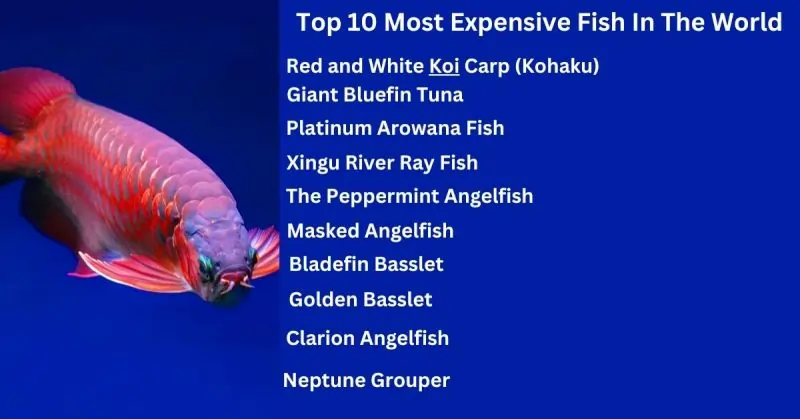The underwater world holds a surprising amount of luxury, and some fish can fetch eye-watering prices! Here at FishlyFun, we’re diving deep into the fascinating (and sometimes bizarre) world of expensive fish. In this blogpost on Top 10 Most Expensive Fish In The World, we will explore the topmost expensive fishes in the universe for the knowledge of Fish lovers.
This top 10 list showcases the priciest fish ever sold. Some are dazzlingly beautiful creatures, perfect for a luxurious home aquarium. Others represent the pinnacle of seafood quality, destined for the most exclusive sushi restaurants. We’ll see everything from record-breaking tuna to fish with unique colors and patterns. So buckle up, fish fans! Get ready to be amazed by the underwater world’s most valuable residents. Just remember, the prices you’ll see are for the highest amount ever paid for a single fish – some real whoppers! Let’s dive in!
Top 10 Most Expensive Fish In The World
Red and White Koi Carp (Kohaku)
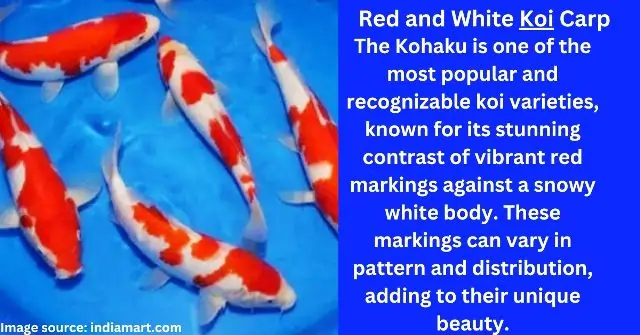
Description:
The Kohaku is one of the most popular and recognizable koi varieties, known for its stunning contrast of vibrant red markings against a snowy white body. These markings can vary in pattern and distribution, adding to their unique beauty.
Features:
- Color: Red and white (Kohaku means “red and white” in Japanese)
- Size: Can grow up to 3 feet (0.9 meters) in length
- Lifespan: 25-35 years with proper care
Price: The price of a Kohaku koi can vary greatly depending on several factors, including:
- Size: Larger koi are generally more expensive.
- Quality of markings: Koi with a clean white base and well-defined red markings are more valuable.
- Bloodline: Koi from champion bloodlines can fetch significantly higher prices.
General price range:
- Smaller Kohaku (6-8 inches): $50-$100
- Medium Kohaku (12-18 inches): $200-$500
- Large Kohaku (24+ inches): $2.0 million/Fish (price can significantly increase depending on quality)
Where to Buy:
Kohaku koi can be purchased from reputable koi breeders, koi farms, and some pet stores specializing in koi.
Note: These are estimated prices and may vary depending on your location and the specific koi you’re interested in.
Giant Bluefin Tuna: A Leviathan of the Sea
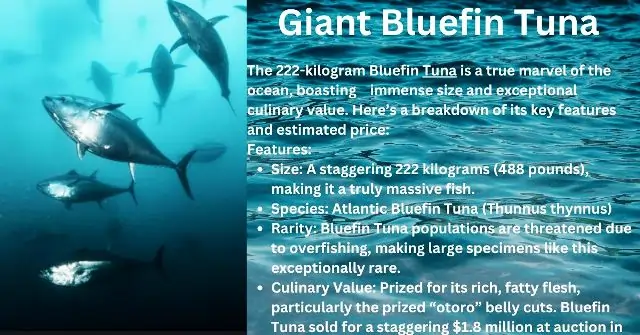
The 222-kilogram Bluefin Tuna is a true marvel of the ocean, boasting immense size and exceptional culinary value. Here’s a breakdown of its key features and estimated price:
Features:
- Size: A staggering 222 kilograms (488 pounds), making it a truly massive fish.
- Species: Atlantic Bluefin Tuna (Thunnus thynnus)
- Rarity: Bluefin Tuna populations are threatened due to overfishing, making large specimens like this exceptionally rare.
- Culinary Value: Prized for its rich, fatty flesh, particularly the prized “otoro” belly cuts.
Estimated Price:
Due to its rarity and size, a 222-kilogram Bluefin Tuna would likely fetch a record-breaking price at auction. Here’s some context for pricing:
- Historical Record: In 2013, a 222-kilogram Bluefin Tuna sold for a staggering $1.8 million at auction in Japan.
- Market Fluctuations: Bluefin Tuna prices can vary depending on market demand, quality, and auction location.
Important Note:
It’s important to be aware of the conservation concerns surrounding Bluefin Tuna. Sustainable fishing practices are crucial to protect these magnificent creatures for future generations.
Platinum Arowana Fish
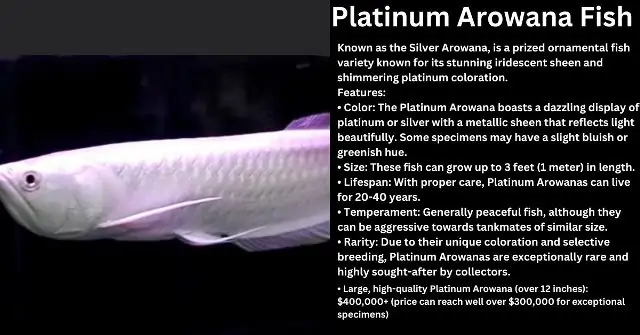
The Platinum Arowana, also known as the Silver Arowana, is a prized ornamental fish variety known for its stunning iridescent sheen and shimmering platinum coloration.
Features:
- Color: The Platinum Arowana boasts a dazzling display of platinum or silver with a metallic sheen that reflects light beautifully. Some specimens may have a slight bluish or greenish hue.
- Size: These fish can grow up to 3 feet (1 meter) in length.
- Lifespan: With proper care, Platinum Arowanas can live for 20-40 years.
- Temperament: Generally peaceful fish, although they can be aggressive towards tankmates of similar size.
- Rarity: Due to their unique coloration and selective breeding, Platinum Arowanas are exceptionally rare and highly sought-after by collectors.
Price:
The price of a Platinum Arowana can vary significantly depending on several factors, including:
- Size: Larger fish generally command higher prices.
- Coloration: The intensity and uniformity of the platinum sheen is a major factor in price.
- Bloodline: Fish from reputable breeders with documented pedigrees are more expensive.
General price range:
- Small Platinum Arowana (4-6 inches): $10,000-$30,000
- Medium Platinum Arowana (8-12 inches): $30,000-$100,000+
- Large, high-quality Platinum Arowana (over 12 inches): $400,000+ (price can reach well over $300,000 for exceptional specimens)
Where to Buy:
Due to their rarity and high cost, it’s crucial to purchase Platinum Arowanas from reputable breeders who prioritize ethical breeding practices and ensure the health of the fish.
Important Note:
Arowanas are large fish that require spacious aquariums, proper water quality maintenance, and a specialized diet. Responsible ownership and commitment to their long-term care is essential.
Xingu River Ray Fish
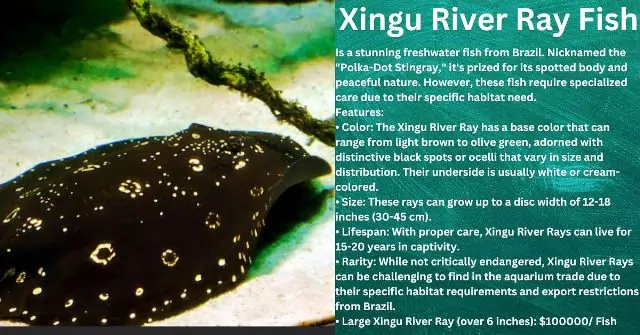
The Xingu River Ray, also known as the Polka-Dot Stingray or Spotted River Ray (Potamotrygon leopoldi), is a captivating freshwater fish species native to the Xingu River basin in Brazil. They are known for their unique spotted patterning and are popular among aquarists for their beauty and relatively peaceful temperament.
Features:
- Color: The Xingu River Ray has a base color that can range from light brown to olive green, adorned with distinctive black spots or ocelli that vary in size and distribution. Their underside is usually white or cream-colored.
- Size: These rays can grow up to a disc width of 12-18 inches (30-45 cm).
- Lifespan: With proper care, Xingu River Rays can live for 15-20 years in captivity.
- Temperament: Generally peaceful fish that can be kept with other peaceful community fish of similar size. However, they are bottom feeders and may compete with other bottom-dwelling fish for food.
- Rarity: While not critically endangered, Xingu River Rays can be challenging to find in the aquarium trade due to their specific habitat requirements and export restrictions from Brazil.
Price:
The price of a Xingu River Ray can vary depending on several factors, including:
- Size: Larger fish generally command higher prices.
- Coloration: Specimens with a dense and well-defined spotted pattern tend to be more expensive.
- Health: Healthy fish from reputable sources will cost more than those from unknown origins.
General price range:
- Small Xingu River Ray (2-3 inches): $150-$300
- Medium Xingu River Ray (4-6 inches): $300-$800
- Large Xingu River Ray (over 6 inches): $100000/ Fish (price can vary depending on factors mentioned above)
Where to Buy:
Due to their specific needs and potential export restrictions, it’s important to find reputable aquaculturists who prioritize captive breeding and ethical sourcing practices.
Important Note:
Xingu River Rays require spacious aquariums with a sandy substrate, hiding places, and pristine water conditions. They are not suitable for beginners due to their specialized care requirements. Responsible ownership and commitment to their long-term well-being is essential.
The Peppermint Angelfish: A Jewel of the Deep Sea
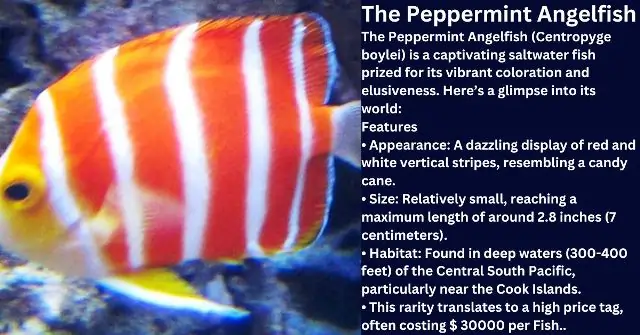
The Peppermint Angelfish (Centropyge boylei) is a captivating saltwater fish prized for its vibrant coloration and elusiveness. Here’s a glimpse into its world:
- Appearance: A dazzling display of red and white vertical stripes, resembling a candy cane.
- Size: Relatively small, reaching a maximum length of around 2.8 inches (7 centimeters).
- Habitat: Found in deep waters (300-400 feet) of the Central South Pacific, particularly near the Cook Islands.
Rarity and Price:
Due to their deep-water habitat and challenging collection methods, Peppermint Angelfish are rare in the aquarium trade. This rarity translates to a high price tag, often costing $ 30000 per Fish..
Important Note:
Peppermint Angelfish require experienced aquarists due to their specific needs. These include a large, well-established saltwater aquarium, proper water parameters, and a peaceful tank environment. They are not recommended for beginners.
Masked Angelfish: A Deep-Sea Beauty Unveiled
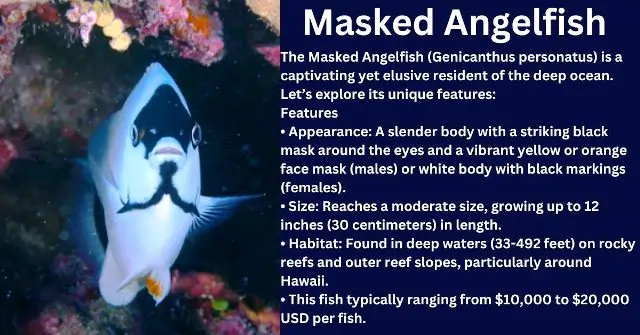
The Masked Angelfish (Genicanthus personatus) is a captivating yet elusive resident of the deep ocean. Let’s explore its unique features:
- Appearance: A slender body with a striking black mask around the eyes and a vibrant yellow or orange face mask (males) or white body with black markings (females).
- Size: Reaches a moderate size, growing up to 12 inches (30 centimeters) in length.
- Habitat: Found in deep waters (33-492 feet) on rocky reefs and outer reef slopes, particularly around Hawaii.
Rarity and Price:
Once nearly impossible to find due to its deep-sea habitat, Masked Angelfish are becoming more available through captive breeding programs. This exclusivity still translates to a high price, typically ranging from $10,000 to $20,000 USD per fish.
Important Note:
Masked Angelfish are not suitable for most home aquariums. They require a large, well-maintained saltwater tank with specific water parameters and a peaceful environment. These factors, along with their high cost, make them ideal for experienced aquarists with the resources to meet their needs.
Bladefin Basslet: A Rare Deep-Sea Gem
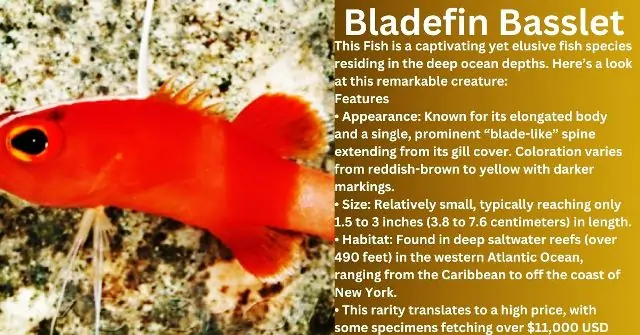
The Bladefin Basslet (Jeboehlkia gladifer) is a captivating yet elusive fish species residing in the deep ocean depths. Here’s a look at this remarkable creature:
- Appearance: Known for its elongated body and a single, prominent “blade-like” spine extending from its gill cover. Coloration varies from reddish-brown to yellow with darker markings.
- Size: Relatively small, typically reaching only 1.5 to 3 inches (3.8 to 7.6 centimeters) in length.
- Habitat: Found in deep saltwater reefs (over 490 feet) in the western Atlantic Ocean, ranging from the Caribbean to off the coast of New York.
Rarity and Price:
Due to their deep-sea habitat and sensitivity to pressure changes during capture, Bladefin Basslet are extremely rare in the aquarium trade. This rarity translates to a high price, with some specimens fetching over $11,000 USD.
Important Note:
The Bladefin Basslet is not recommended for home aquariums. Their deep-sea origin requires specialized care, including a cold-water tank with high water pressure and minimal lighting. They are also reportedly aggressive towards tankmates, making them a challenging fish to keep. These factors make them best suited for public aquariums or highly experienced aquaculturists with the resources to meet their specific needs.
Golden Basslet: A Sunbeam Beneath the Waves

The Golden Basslet (Gramma dejongi), also known as the Cuban Golden Basslet, is a dazzling fish prized for its vibrant color and peaceful nature. Let’s dive into its characteristics:
- Appearance: Stunningly beautiful with a bright yellow body and contrasting purple markings on its fins and belly.
- Size: Relatively small, typically reaching a maximum length of 1.7 inches (4.3 centimeters).
- Habitat: Found in coral reefs of the tropical Caribbean Sea, particularly near Cuba.
Rarity and Price:
While not as common as some other basslet varieties, the Golden Basslet is becoming more available due to successful captive breeding programs. This has made them more accessible to hobbyists, with prices typically ranging from $50 to $8000 USD depending on size and coloration.
Important Note:
Golden Basslets are generally peaceful fish, making them ideal for reef aquariums with other compatible tankmates. They thrive in well-maintained saltwater tanks with moderate water flow and plenty of hiding places. While not the rarest fish, they are still a captivating addition for saltwater aquarium enthusiasts.
Clarion Angelfish: A Sun-Kissed Beauty (Vulnerable)
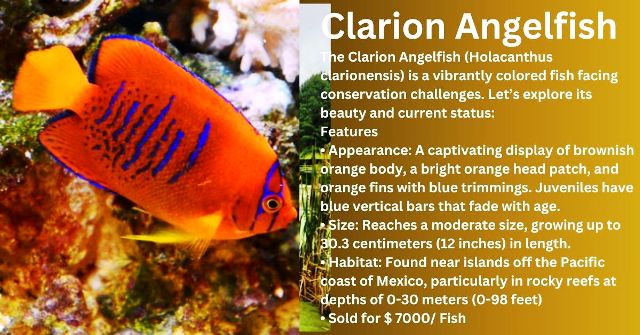
The Clarion Angelfish (Holacanthus clarionensis) is a vibrantly colored fish facing conservation challenges. Let’s explore its beauty and current status:
- Appearance: A captivating display of brownish orange body, a bright orange head patch, and orange fins with blue trimmings. Juveniles have blue vertical bars that fade with age.
- Size: Reaches a moderate size, growing up to 30.3 centimeters (12 inches) in length.
- Habitat: Found near islands off the Pacific coast of Mexico, particularly in rocky reefs at depths of 0-30 meters (0-98 feet).
Rarity and Price:
Due to overfishing and habitat degradation, the Clarion Angelfish is classified as “Vulnerable” by the IUCN. This has led to restrictions on the wild-caught trade, making them less common and potentially more expensive in the aquarium trade. Sold for $ 7000/ Fish.
Important Note:
The ethical sourcing of Clarion Angelfish is crucial. Consider captive-bred specimens if available to avoid contributing to wild population decline. They require a large, well-maintained saltwater tank with plenty of hiding places and a peaceful environment. Due to their specific needs, they are best suited for experienced aquarists.
Neptune Grouper: A Treasure of the Deep
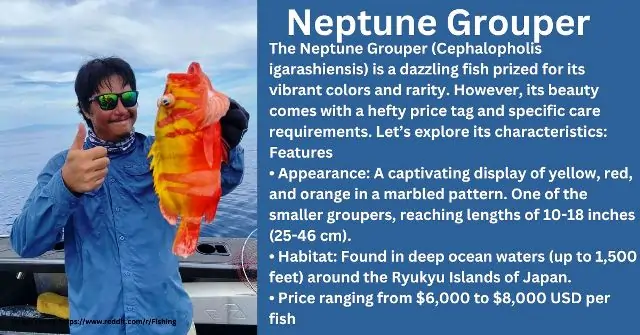
Image source: https://www.reddit.com/r/Fishing
The Neptune Grouper (Cephalopholis igarashiensis) is a dazzling fish prized for its vibrant colors and rarity. However, its beauty comes with a hefty price tag and specific care requirements. Let’s explore its characteristics:
- Appearance: A captivating display of yellow, red, and orange in a marbled pattern. One of the smaller groupers, reaching lengths of 10-18 inches (25-46 cm).
- Habitat: Found in deep ocean waters (up to 1,500 feet) around the Ryukyu Islands of Japan.
Rarity and Price:
Due to its deep-sea habitat and difficulty in catching (requiring decompression to avoid death), the Neptune Grouper is exceptionally rare. This rarity translates to a very high price, often ranging from $6,000 to $8,000 USD per fish.
Important Note:
The Neptune Grouper is not recommended for home aquariums. These deep-sea fish require specialized care, including a cold-water tank with high water pressure, minimal lighting, and a constant food supply. They are best suited for public aquariums or highly experienced aquaculturists with the resources to meet their specific needs. Additionally, due to their rarity, ethical considerations regarding wild-caught specimens are important.
The Most Expensive Fish You’ve Never Seen
While the Platinum Arowana is often cited as the most expensive fish, due to its stunning coloration and rarity, it’s important to note that the trade in endangered fish is illegal. These magnificent creatures are native to Southeast Asia and hold cultural significance in some Asian countries. However, their endangered status necessitates their protection, not exploitation
FAQ on ” Top 10 Most Expensive Fish In The World
Q- Why are some fish so expensive?
A- Rarity, beauty, and exceptional size can all contribute to a fish’s high price tag.
Q- Are these expensive fish good to eat?
A- While some are prized for their culinary value, many on this list are for display in aquariums, not for eating.
Q- Can I buy one of these fish for my home aquarium?
A- Some can be kept in home aquariums with proper care, but many require very specific and expensive setups
Q- Where can I learn more about these exotic fish?
A- Look for resources on saltwater fish care or specific breeds that interest you.
Blogpost conclusion– Top 10 Most Expensive Fish In The World
So there you have it! Our fin-tastic tour of the most expensive fish on the planet. These underwater stunners, from dazzling aquarium showpieces to incredibly rare catches, showcase the remarkable value some fish can hold. Thanks for joining us at FishlyFun, and happy fishkeeping (or marveling at the underwater world)!
